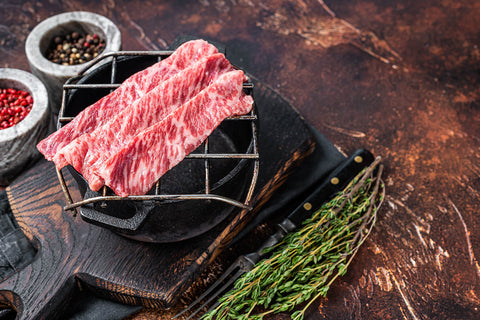
Furikake is a popular Japanese condiment, often sprinkled over cooked rice, fish, and vegetables to add flavour, or incorporated into onigiri (rice balls), pickling liquid, and more. While it typically comprises bonito flakes, sesame seeds, nori, salt, sugar, and monosodium glutamate (MSG) some brands incorporate other ingredients to produce their own distinct flavour.
History
While many Japanese ingredients have stories that stretch back centuries, the history of furikake is comparatively recent. The most commonly-accepted back-story for the condiment is that it was invented by a Kumamoto pharmacist, Suekichi Yoshimaru, during the Taishō period (1912–1926). The original furikake had medicinal qualities, being a powdered mixture of crushed seaweed, poppy seeds, roasted sesame seeds, and fish bones, intended to add calcium to a person’s diet. This product – called Gohan no Tomo, meaning “a friend for rice” – is considered the prototype for what would become known as furikake.
Following World War II, Nissin Foods started manufacturing their own version of furikake on a large scale. Again, this was done for nutritional reasons, addressing the widespread malnourishment in the country at that time. It was a good source of calcium and protein and easily dispensed across Japan at a low cost that allowed all households to benefit from it.
The name “furikake” became the formal term for a range of similar products in 1959, when the National Furikake Association was first formed.
How to make furikake
While many people favour the convenience of a store-bought furikake, it is easy to make at home. You toast your sesame seeds and nori and grind them, either by hand or in a food processor. To this you add salt and sugar, along with any other ingredients you wish to incorporate. This can include bonito flakes, dried shitake mushrooms, miso powder, poppy seeds, chili flakes, and more. Mix the ingredients well, grinding further if you want a finer consistency. Seal in an airtight container.
Uses of furikake in Japanese cooking
For such a simple condiment, furikake has many uses in Japanese cuisine. These are some of the most common applications you are likely to come across:
seasoning: we’ve already discussed how furikake is used to season onigiri and plain white rice, but it can be added to many other dishes, including stews, ramen, udon, and miso soup.garnishing: furikake is often added as a simple garnish to fish (both steamed and fried) and roasted vegetables, as well as to savoury grain porridge.
topping: furikake goes great with eggs, whether you prefer them fried, scrambled, or served as omelettes. It can add a noticeable punch to otherwise bland-tasting dishes. It’s also a popular topping for avocado.
snacking: not on its own, obviously – but a generous helping of furikake added to popcorn, granola, or plain toasted nuts is a simple way to create a healthy, savoury snack.
Similar condiments
While furikake is the go-to rice seasoning in Japan, there are several other condiments that are used in a similar manner, either sprinkled over rice, or mixed into other ingredients to enhance the flavour or texture. These are some of the more popular ones:
Gomashio
Another dry condiment like furikake, gomashio is a simple mix of salt and unhulled sesame seeds (although some commercial varieties mix sugar in with the salt). It is used in the same way as furikake, being sprinkled over plain rice or mixed in with onigiri for added texture and flavour. It is most commonly added as a topping for sekihan – a traditional dish of sticky rice and azuki beans.
Being such a simple condiment to prepare, gomashio is often made at home. Either tan or black sesame seeds are toasted before being mixed with the salt (which can also be toasted, if preferred). Both are then hand-ground using a suribachi.
Shichimi
Shichimi (or, to give it its full name, shichi-mi tōgarashi (seven-flavour chili pepper) is another common flavouring mix, popular in Japanese cuisine. In many ways, it is a more complex variation of furikake, since it also has a base of sesame seeds and seaweed. With different types of chili pepper, ginger, and roasted citrus peel, it boasts more detailed and intricate flavour notes.
A typical shichimi mix comprises coarsely ground red chili pepper, ground sanshō pepper, black and white sesame seeds, roasted orange peel, ground ginger, hemp seeds, poppy seeds, and nori. Shichimi – like furikake – is a generic term, and many manufacturers have their own unique recipes, with some adding or substituting different ingredients from this list.
Popular Products
These are just some of the furikake products and variations that prove particularly popular at SushiSushi. Click on a link to learn more, or visit our online store for more furikake products.
Daihoku Katsuobushi & Nori Furikake
One of the most popular furikake products we supply, Daihoku katsuobushi and nori furikake is used in the creation of first-class dishes in several Michelin-starred restaurants across the UK. Flavoured with quality bonito flakes, seasoned nori, shiitake mushrooms, and matcha, this is a uniquely-blended furikake with a distinct taste.
Tanaka Mixed Grain Furikake Rice Seasoning
This mixed-grain furikake mix including brown rice grains and barley among the usual ingredients of seaweed and sesame seeds. The result is a unique blend of flavours and textures that adds a whole new dimension to even the humblest bowl of rice or onigiri.
Yawataya Isogoro Shichimi Togarashi
Another popular condiment in Japanese kitchens is shichimi. This particular blend, from Yawataya Isogoro is a secret blend of ginger, shisho, sansho, nanba chilli pepper, rape seed, sesame, cinnamon, and white pepper. A delicious addition to many dishes, it is used by Michelin-starred chefs Gareth Ward and Sat Bains.
Our Suppliers
Here at SushiSushi, we source our furikake from some of the most well-respected and established producers in Japan. These include:
Daihoku
Founded in 1974 as a nori manufacturer, Daihoku now produces an extensive range of processed marine agricultural products, including furikake. Based in Hokkaido, they use the highest quality ingredients, locally-sourced, to deliver exciting products that are packed with flavour.
Tanaka Foods
Established in 1927, Tanaka Foods was instrumental in the development of furikake from a bespoke medication into a commercial foodstuff. Since then, they have continued to experiment and innovate, producing furikake of exceptional quality for homes and restaurants throughout Japan.
Yawataya Isogoro
Yawataya Isogoro was founded in the Nishiyama area of Japan in the early 18th century. This part of the country was the ideal location for growing six of the key ingredients of their famous shichimi seasoning. The company has grown from strength to strength, but still relies on local ingredients.














